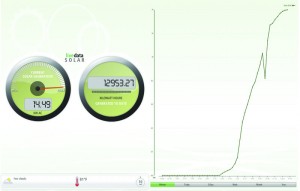While there’s one Facilities project at the top of Campus Operations and Plant Manager Mark Ferguson’s mind right now, the list of sustainability-related changes happening on the operations side is lengthy.
“I got here at the end of ’12, and so really in ’13 we started organizing and analyzing” benchmark data, Ferguson said. “Since then we’ve been just busy, busy, busy doing everything we can. There’s just a lot of good opportunities. We’ve got multiple things going.”
Just a handful of projects recently completed include:
Improving the ventilation, and therefore indoor air quality, in Packard Hall, and improving the fume hoods at Barnes Science Center to optimize indoor air quality and system efficiency.
Prototyping solar thermal on the cooking operations at Worner Center.
Changing out metal halide lighting to LEDs in many buildings across campus; in Cossitt Hall they’ve not only increased light quality, but cut energy 75 percent, with paybacks in less than a year, Ferguson said.

A snapshot of the college’s digital energy dashboard taken in June shows real-time power generated by solar panels on the roof of Spencer Center. The dashboard also displays how many lightbulbs are powered by the same energy, how many trees equal the same carbon dioxide offset, and how many tons of carbon emissions and how many gallons of gasoline are saved.
The trend is that we’re bringing energy use and carbon emissions down, and we’re keeping our costs level even though rates are really increasing on utilities. Over the past four years, energy intensity on campus has been reduced by 12 percent, and carbon emissions from energy use are down 15 percent. Since 2008 we have realized more than $3 million in avoided utilities costs.”
All said, the current project of particular interest for Ferguson began June 1: automating the central plant, the facility responsible for supplying heating and cooling to most of the campus.
They’ve seen utilities savings, Ferguson said, simply by modulating building temperatures based on weather and demand.
The central plant is also going from a 24-hour-a-day, 7-day-a-week, 365-days-a-year manning of the plant, to unmanned periods of time, primarily during the summer, when operators can instead be used to do preventative maintenance on the high temperature hot water distribution system across campus.
“We’re going to work on cleaning the heat exchangers, make sure they’re operational. What we’re trying to do is improve reliability on the system, and improve efficiency.”